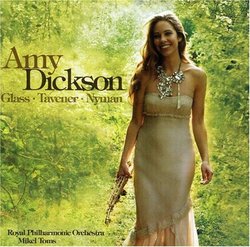Fabulous!
Irishise | 12/17/2009
(5 out of 5 stars)
"In Ms. Dickson's second CD release, we hear another side of this great performer. While "Smile" leaves you doubtless of her ability to create a stunningly smooth tone & sculpt sweet melodies like great works of art, this second album reveals Ms. Dickson's fantastic rhythmic integrity and acrobatic prowess. As always, playful imagination and gorgeous sensitivity are present in every phrase. This album will not disappoint - please, if you are jaded by the hackneyed tunes of a certain performer whose name begins with a "K" and ends with "enny G", it's time you were educated by a true saxophonist. Brilliant recording!"
A talent to watch
A. Bjelland | NYC | 06/06/2010
(4 out of 5 stars)
"In response to the 2-star "non-review" on this page by L. Caldas, while I agree that the marketing of classical music by some of the big labels is unfortunate (and, thankfully, as more and more folks switch to digital downloads, it's becoming less and less relevant), Amy Dickson's playing is pretty extraordinary. While the choice of repertoire may seem a little too "cross-over" for some, the playing on display quickly quells any fears that this is all part of a some slick marketing ploy.
In the Glass and Tavener pieces, both original transcriptions of works originally conceived for solo string instruments (and so there actually are no "other recordings of this music" exactly to refer to), Dickson displays an amazing technique and makes the listener wonder where she has a chance to breathe (something which isn't an issue for the soloist in the string originals)! The transcription of Glass's Violin Concerto (Glass / Rorem / Bernstein: Violin Concertos / Serenade), which opens the disc, works better than I ever thought it would and sounds quite natural in the new guise; the passages with double- and triple-stopping on the violin are neatly adapted to the saxophone with grace notes and other ornaments - similar to Stinton's arrangement of Barber's Violin Concerto for flute (Barber & Khachaturian: Flute Concertos).
Tavener's "The Protecting Veil" (Tavener: The Protecting Veil, The Last Sleep of the Virgin, Choral Music) was originally scored for cello and string orchestra. The liner notes state that only the first section of the eight movement work is transcribed for this recording, but at almost 15 minutes it must consists of a bit more than that (the original first movement only lasts about 9 minutes, and the playing here isn't significantly slow enough to account for the 6 minute difference). Perhaps Dickson has incorporated a "bridge" section and the reprise of the opening that makes up the last movement of the original work as well, or perhaps she repeats the opening music in an ornamented way - I'd have to give the original a more careful audition to figure out just what's going on. Regardless, the final result works quite well: the saxophone is an admirable stand-in for the original (generally high-register) cello solo, contrasting nicely with the rich, slow moving string textures of the orchestra as they ebb and flow below the chanting, sighing and singing lines of the soloist, occasionally giving way to bell-like peals from the higher strings. One strange side-effect of the transcription: the new "reedy" soloist brought to mind passages from the opening movement of Copland's Clarinet Concerto!
In the one work originally written for saxophone, Nyman's "Where the Bee Dances," she does a fine job as well, though Dickson's recording is perhaps not quite as distinctive as the accounts by Harle (Saxophone Works: Nyman: Where the Bee Dances / Bryars: The Green Ray / Westbrook: Bean Rows and Blues Shots/ Bournemouth Sinfornietta), Haram (Piano Concerto / Where the Bee Dances) and, especially, McChrystal (Meeting Point: The Saxophone Concertos of Nyman, Heath and Torke). Based in part on Nyman's earlier setting of Shakespeare's song of the same title (from 'The Tempest') for Peter Greenaway's film, Prospero's Books, the work transcends its film music origins and makes a fitting and exciting conclusion to a most-intelligently planned and musical program.
Dickson is a talent to watch, and one hopes she will receive commissions from contemporary composers and explore works for other members of the saxophone family to show her technique in "standard" repertoire (though, since we're talking about instruments that weren't even around before the 1840s, this is still a relatively small selection of works)."


 Track Listings (5) - Disc #1
Track Listings (5) - Disc #1